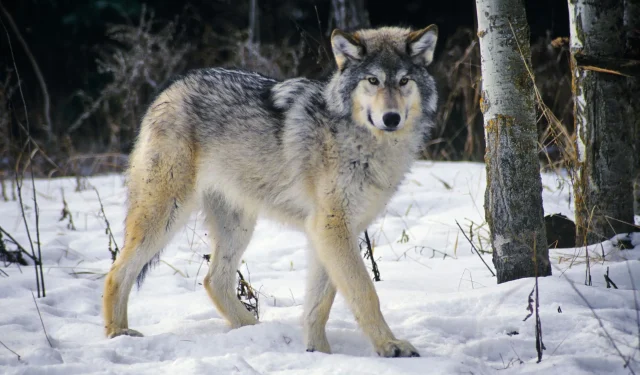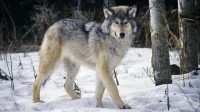Netizens Respond to TIME Magazine Feature on De-Extinct Dire Wolf Remus
The online community has erupted with reactions to Remus, a dire wolf gracing the cover of TIME magazine. As reported by The Economic Times, scientists from Colossal Biosciences, a biotech firm, have successfully revived the dire wolf, a species that disappeared approximately 10,000 years ago.
On April 7, 2025, the Dallas-based company introduced Remus and Romulus, heralded as “the world’s first de-extinct animals,” during an announcement on X, a social media platform. These wolves were born on October 1, 2024, sparking excitement and curiosity across various online forums.
“These two wolves were brought back from extinction using genetic edits derived from a complete dire wolf genome, meticulously reconstructed by Colossal from ancient DNA found in fossils dating back 11,500 and 72,000 years. This moment marks not only a milestone for us as a company but also a leap forward for science, conservation, and humanity,”the post explained.
The excitement didn’t end with the initial announcement. A female dire wolf named Khaleesi was added to the mix, being born in January 2025, further solidifying the company’s commitment to reviving extinct species. TIME Magazine incorporated Remus into the cover of its May 2025 issue, featuring a striking red strikethrough across the word “Extinct.”
“This is Remus. He’s a dire wolf. The first to exist in over 10,000 years. Endangered species could be changed forever,”the caption read.
The public’s response on X has been lively, with many expressing their thoughts and humor regarding the re-emergence of these formidable creatures. One user made a playful reference to the dire wolves belonging to the Stark family from the popular TV series, Game of Thrones.
“He belonged to which Stark kid?”the user quipped.
Another user chimed in, humorously suggesting sibling rivalry with a comment about Romulus’s feelings regarding the cover:
“Romulus is going to be pissed — why does only Remus get the cover!? You can’t fit both? This is why brothers have issues,”
While many celebrated this scientific advancement, others expressed cautious skepticism. Concerns were raised about the ecological implications of resurrecting extinct species. One user wrote:
“Don’t know how anyone else feels, but I find this concerning. What’s next? Jurassic park?”
Some users pointed out the nuances of genetics involved in this process. One user shared pertinent insights about the genetic differences:
“Due to the cloning process, and extraction method developed to harvest what little DNA is needed for replicating and genetic editing, there is a slight aberration in the Genome of this animal. It is not actually a Dire Wolf; it is about as close as we can currently get to one,”
Another user brought attention to the social considerations of the revived species, noting the potential mating issues:
“That dire fella ain’t gonna get to MATE, so… He’s not so happy.”
On a more positive note, one user expressed a sense of awe at the revival of such a majestic species:
“Whoa, I love the idea of a dire wolf back in the spotlight! Remus looks absolutely majestic. Do you think we’re ready for a world where extinct species could come back?”
Discussion on these topics continues, with various users weighing in on the ethical and ecological ramifications:
“Things become extinct for a reason. Do you find human intervention to always be the best measure?”
“Jurassic park just became a real possibility, we are cooked!”
This mix of enthusiasm and caution reflects the complexities surrounding the revival of extinct species and hints at the consequences of such scientific endeavors.
About Colossal Biosciences: Leading the De-Extinction Charge

Colossal Biosciences, founded in 2021 by CEO Ben Lamm, is at the forefront of de-extinction efforts. With prominent investors including Paris Hilton and Chris Hemsworth, this Dallas-based company aims to challenge nature by resurrecting long-gone species. Beth Shapiro, an experienced evolutionary molecular biologist, serves as the company’s Chief Science Officer, while OpenAI’s CEO Sam Altman also lends his expertise as an advisor.
Currently, Colossal is also working on bringing back the woolly mammoth, which has been extinct for about 4,000 years. The company has collected genomic data from 60 mammoth specimens preserved in Arctic permafrost to aid in their quest. Remarkably, early experiments have yielded positive results, as seen in the case of two engineered mice, Chip and Dale, which showcased traits reminiscent of their woolly counterparts.
“The Colossal Woolly Mouse marks a watershed moment in our de-extinction mission,”Lamm stated.
Colossal’s vision also encompasses plans for recreating the woolly mammoth, the dodo bird, and the Tasmanian tiger, aiming to challenge our understanding of extinction and conservation.
As humanity navigates the uncharted territory of de-extinction, the discussions surrounding this movement become crucial. While the potential of reintroducing extinct species opens new avenues for biodiversity, it also calls for a careful examination of ecological balance and long-term implications.


